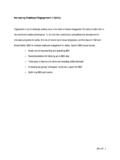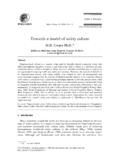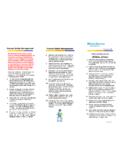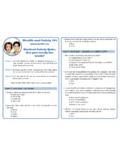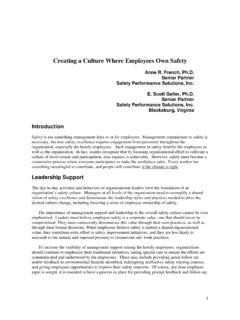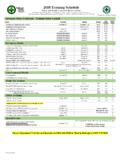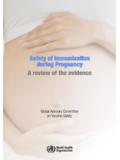Transcription of Safety in Numbers: The Development of Leapfrog’s Composite ...
1 J Patient Saf Volume 9, 2013 Austin et al Safety in Numbers 1 Pre-Published Ahead of Print: 04/01/2013 2013 Lippincott Williams & Wilkins ORIGINAL ARTICLE Safety in Numbers: The Development of Leapfrog s Composite Patient Safety Score for Hospitals J. Matthew Austin, PhD1, Guy D Andrea, MBA2, John D. Birkmeyer, MD3, Lucian L. Leape, MD4, Arnold Milstein, MD5, Peter J. Pronovost, MD, PhD6, Patrick S. Romano, MD7, Sara J. Singer, MBA, PhD8, Timothy J. Vogus, PhD9, and Robert M. Wachter, MD10 Objective: To develop a Composite patient Safety score that provides patients, health care providers, and health care purchasers with a standardized method to evaluate patient Safety in general acute care hospitals in the United States.
2 Methods: The Leapfrog Group sought guidance from a panel of national patient Safety experts to develop the Composite score. Candidate patient Safety performance measures for inclusion in the score were identified from publicly-reported national sources. Hospital performance on each measure was converted into a z-score and then aggregated using measure-specific weights. A reference mean score was set at three, with scores interpreted in terms of standard deviations above or below the mean, with above reflecting better than average performance. Results: Twenty-six measures were included in the score. The mean Composite score for 2,652 general acute care hospitals in the was (range by hospital, to ).
3 Safety scores were slightly lower for hospitals that were publicly owned, rural in location, or that had a larger percentage of patients with Medicaid as their primary insurance. Conclusions: The Leapfrog patient Safety Composite provides a standardized method to evaluate patient Safety in general acute care hospitals in the United States. While constrained by available data and publicly reported scores on patient Safety measures, the Composite score reflects the best available evidence regarding a hospital s efforts and outcomes in patient Safety . Additional analyses are needed, but the score did not appear to have a strong bias against hospitals with specific characteristics.
4 The Composite score will continue to be refined over time as measures of patient Safety evolve. Key words: patient Safety , hospital, performance measures, Composite , score From: Johns Hopkins University School of Medicine. Baltimore, MD. Consulting, LLC. Baltimore, MD. of Michigan Medical School. Ann Arbor, MI School of Public Health. Boston, MA University School of Medicine. Stanford, CA. Johns Hopkins University School of Medicine. Baltimore, MD. of California (UC) Davis School of Medicine. Sacramento, CA 8. Harvard School of Public Health. Boston, MA University Owen Graduate School of Management. Nashville, TN. of California (UC) San Francisco. San Francisco, CA Disclosure: M.
5 Austin has a contract with The Leapfrog Group for Hospital Safety Score guidance. P Romano has a pending grant from AHRQ through Battelle Memorial Institute to provide clinical and methodologic expertise in the AHRQ Quality Indication Program; he provides expert testimony related to use of the AHRQ Patient Safety Indicators and other components of the Leapfrog Composite for evaluating hospital performance; he provides consultancy to AHRQ Patient Safety Indicators for international comparison of hospital performance and for evaluating the impact of resident duty; and he serves on the Blue Ribbon Expert Panel that advised the Leapfrog Group on construction of its Patent Safety Composite .
6 G. D'Andrea of Discern Consulting provides consulting services and program support for The Leapfrog Group. P. Pronovost is a Board Member of Cantel Medical Group, is a paid consultant of Association of Professionals in Infection Control & Epidemiology, and has a pending grant from AHRQ. Funding Support: Discern Consulting contributed program support to The Leapfrog Group toward the manuscript. Correspondence: J. Matthew Austin, PhD. Instructor, Armstrong Institute for Patient Safety and Quality, The Johns Hopkins University School of Medicine; 750 E. Pratt St, 15th Floor, Baltimore, MD 21202. Telephone: Fax: email: Copyright 2013 Lippincott Williams & Wilkins. Unauthorized reproduction of this article is prohibited.
7 Despite the hundreds of thousands of patients who suffer preventable harm each year in US hospitals,[1] patients, health care providers, and health care purchasers lack a standardized method to evaluate patient Safety in US hospitals. This lack of standardized evaluation is especially concerning given recent evidence that many US hospitals have made small incremental improvements in Safety or continue to harm patients in large numbers.[2,3,4,5] While the number of publicly-reported patient Safety measures has grown over the last decade,[6,7] there is little evidence that patients and providers are using these data to inform their choice of hospital.
8 [8,9] One possible explanation for the lack of use is that Safety data have typically been reported on a measure-by measure basis, requiring patients and providers to synthesize many disparate data points in their decision making process. Composite measures, which combine multiple performance measures using a pre-determined weighting methodology to produce a single score, provide a more general picture of the Safety performance of a hospital, making it more understandable and usable for non-medical personnel.[10] However, while Composite measures are easier for patients to understand, they can mask a hospital s excellent or poor performance on individual measures.
9 Additionally, the pre-determined weights assigned to each measure may not reflect the preferences of individual patients.[11] Nevertheless, the potential to motivate patient and provider response, and thereby improve patient utility, makes it worthwhile to develop a Composite measure of hospital patient Safety . The Leapfrog Group, a national coalition of health care purchasers, sought to address the need for a standardized method for evaluating patient Safety in US hospitals by creating a Composite Safety score. The primary goal was a single, publicly available Safety score J Patient Saf Volume 9, 2013 Austin et al Safety in Numbers 2 Pre-Published Ahead of Print: 04/01/2013 2013 Lippincott Williams & Wilkins for every US hospital, including hospitals that do and do not voluntarily participate in the Leapfrog Hospital Survey.
10 Other national organizations, such as Consumer Reports and US News & World Report, have developed their own Composite measures of hospital performance. These organizations, however, have taken quite different approaches to constructing composites. US News relies heavily on reputational surveys and focuses on major academic medical centers and large sized hospitals, whereas Consumer Reports relies heavily on patient experience surveys and readmission rates that favor small to-medium sized community hospitals.[12,13,14] Leapfrog s goal was to balance many different measures of structures, processes, and outcomes that have been linked to patient Safety , but which may or may not be related to each other, in order to improve patient and clinician selection of hospitals and to more strongly motivate and better target hospital Safety improvement efforts.
